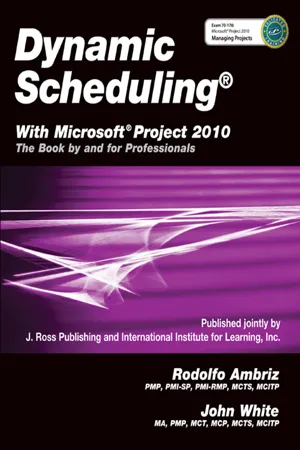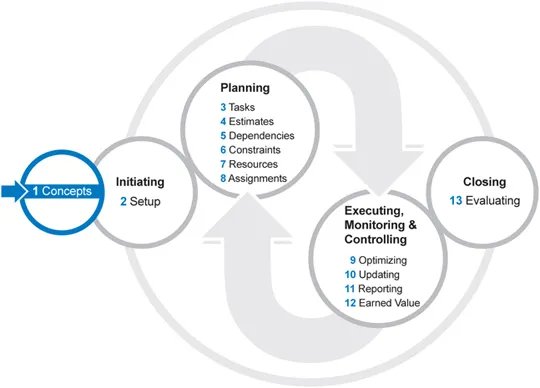
eBook - ePub
Dynamic Scheduling® With Microsoft® Project 2010
The Book By and For Professionals
- 832 pages
- English
- ePUB (mobile friendly)
- Available on iOS & Android
eBook - ePub
Dynamic Scheduling® With Microsoft® Project 2010
The Book By and For Professionals
About this book
Formally validated training material to pass Microsoft certification Exam 70-178: Microsoft Project 2010, Managing Projects! Designed for the busy, practicing project manager, Dynamic Scheduling With Microsoft Project 2010 will help you get up to speed quickly with the new features of Project 2010 and enable you to create effective schedules more efficiently using best practices, tips & tricks, and step-by-step instruction. Through the use of helpful screen shots, hands-on exercises, illustrations, and review questions, this guide instructs you on how to build dynamic schedules that will allow you to explore what-if scenarios and dramatically decrease the time you spend making static schedule changes. "A must read, re-read, and use daily for all project managers" is what PMI's Project Management Journal had to say about the previous edition. This updated version is even better.
Frequently asked questions
Yes, you can cancel anytime from the Subscription tab in your account settings on the Perlego website. Your subscription will stay active until the end of your current billing period. Learn how to cancel your subscription.
At the moment all of our mobile-responsive ePub books are available to download via the app. Most of our PDFs are also available to download and we're working on making the final remaining ones downloadable now. Learn more here.
Perlego offers two plans: Essential and Complete
- Essential is ideal for learners and professionals who enjoy exploring a wide range of subjects. Access the Essential Library with 800,000+ trusted titles and best-sellers across business, personal growth, and the humanities. Includes unlimited reading time and Standard Read Aloud voice.
- Complete: Perfect for advanced learners and researchers needing full, unrestricted access. Unlock 1.4M+ books across hundreds of subjects, including academic and specialized titles. The Complete Plan also includes advanced features like Premium Read Aloud and Research Assistant.
We are an online textbook subscription service, where you can get access to an entire online library for less than the price of a single book per month. With over 1 million books across 1000+ topics, we’ve got you covered! Learn more here.
Look out for the read-aloud symbol on your next book to see if you can listen to it. The read-aloud tool reads text aloud for you, highlighting the text as it is being read. You can pause it, speed it up and slow it down. Learn more here.
Yes! You can use the Perlego app on both iOS or Android devices to read anytime, anywhere — even offline. Perfect for commutes or when you’re on the go.
Please note we cannot support devices running on iOS 13 and Android 7 or earlier. Learn more about using the app.
Please note we cannot support devices running on iOS 13 and Android 7 or earlier. Learn more about using the app.
Yes, you can access Dynamic Scheduling® With Microsoft® Project 2010 by Rodolfo Ambrix,John White in PDF and/or ePUB format, as well as other popular books in Commerce & Gestion de projet. We have over one million books available in our catalogue for you to explore.
Information
Chapter 1: Concepts of Project Management

To use Project 2010 effectively, you’ll want to understand the project management concepts and processes that the tool supports. In this chapter we’ll look at the big picture of project management. We’ll discuss what project management is and where it fits in the enterprise and in the context of programs and portfolios.
After reading this chapter you’ll be able to:





I think I should start learning about dynamic models...
Overview
In this chapter, we’ll define what projects and project management are, position project management in the context of the multi-project enterprise and finally focus in on the principles and processes for managing individual projects.
This book deals primarily with managing a single project but we do address some issues related to multiple projects. This is because we rarely perform a project in a vacuum: multiple projects performed simultaneously have become the norm. Some projects are logically related to one another, while others may be related only because they share resources and occur within the same organization.
Project 2010 provides features and functions that help you manage multiple projects and we’ll point those out throughout the book. However to fully address multi-project management, you’ll need Project Server, the software that enables multiple users to effectively collaborate on projects.
What is Project Management?
“Project management (PM) is the application of knowledge, skills, tools and techniques to project activities to meet project requirements. Project management is accomplished through the application and integration of the project management process groups: initiating, planning, executing, monitoring and controlling, and closing.”1
The project management process is effective when projects are aligned with the organization’s strategy, completed to the satisfaction of the client and sponsor, and produced on time and within schedule.
Why Project Management
Projects are critical to the success of any organization: they are how an organization gets new things done. But projects are often poorly managed and the costs of this mismanagement are high. They include projects that are late, over budget, produce substandard products, don’t satisfy stakeholders and don’t align with the organization’s business strategy.
Projects are by nature complex: they involve people and variables that make it impossible to follow a simplistic cookbook approach and to predict outcomes with complete accuracy. We need project management to manage dynamic and complex efforts to achieve objectives within a project’s competing demands of scope, time, cost, quality, resources and risk.
Completing projects efficiently and effectively provides a competitive edge and enables an organization to improve the way it serves its clients, stakeholders and employees. Project management improves the likelihood that projects will be completed successfully.
What is a Project?
“A project is a temporary endeavor undertaken to create a unique product, service or result.”2
Projects are the means for making all changes (new and improved products and processes, mergers and acquisitions, etc.) in any organization. They represent a significant expenditure of money and critical resources. Projects are critical factors in meeting strategic goals and objectives.
Some organizations have projects as their core operations, like construction, aerospace and consulting companies. There are full-time project managers in these companies. In other organizations, projects are often used to implement changes (like relocations and reorganizations) or for creating new systems (such as information and financial systems). These organizations may also have professional project managers, but many projects may be managed by occasional or incidental project managers. The line manager of today often has one or more projects in progress.
Examples of Project
Here is a list of some common project types with examples. Each may have a wide range of complexity, cost, duration and criticality.







A Word About Small Project
There is a tendency to downplay the importance of small projects to justify not bringing project management principles into play. Small projects are as important as any, particularly because there are so many of them and they may be critical to business operations.
The formality of project management must be scaled to the size, complexity and setting of the project to be managed. The fact that a project is small may seem to indicate less of a need for formality. However, when there is a dynamic flow of many small projects, as in a maintenance environment, you may in fact need greater formality.
Some small projects are complex and critical. For example, when a condenser needs to be replaced in a coal-fueled power plant (a project that is small in the context of major facilities projects), it can require that operations be suspended for several weeks. The potential for this “small” project to fall off track has huge financial consequences and therefore a need for greater formality.
Every project needs to be managed carefully.
Enterprise Project Management (EPM)
Project management is a process designed to improve project performance. Before we look at the principles of managing a single project, it’s important to understand the context within which projects exist.
Enterprise Project Management (EPM) or Organizational Project Management (OPM) is the higher-level process within which project management fits. EPM improves organizational performance by linking project work, along with operational work, to organizational strategy.
EPM addresses the multi-project environment of an organization and the relationships between projects, programs, portfolios of proj...
Table of contents
- Cover
- Title
- Copyright
- A Message from E. LaVerne Johnson CEO, President and Founder - International Institute for Learning, Inc.
- International Institute for Learning, Inc. (IIL)
- Download Resource Center
- Short Table of Contents
- Long Table of Contents
- What’s New in This Edition
- Foreword by Dr. Harold Kerzner
- Acknowledgments
- Introduction
- About This Book
- Chapter 1: Concepts of Project Management
- Chapter 2: Getting Started with Project 2010
- Chapter 3: Entering Tasks
- Chapter 4: Entering Estimates
- Chapter 5: Entering Dependencies
- Chapter 6: Entering Deadlines, Constraints and Task Calendars
- Chapter 7: Entering Resources
- Chapter 8: Entering Assignments
- Chapter 9: Optimizing the Schedule
- Chapter 10: Updating the Schedule
- Chapter 11: Reporting
- Chapter 12: Earned Value Management
- Chapter 13: Evaluating the Project
- Chapter 14: Summary
- Appendix 1: Case Studies
- Appendix 2: Consolidated Schedules